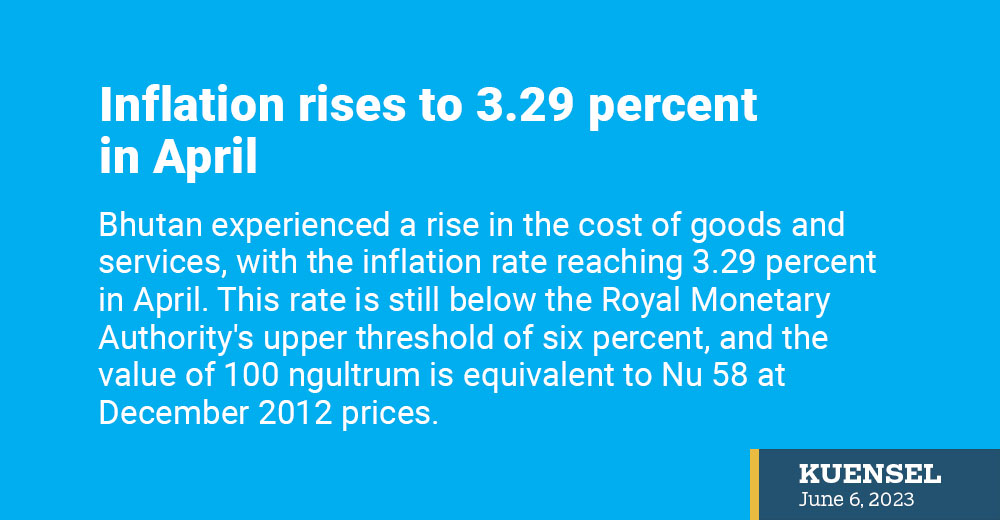Thukten Zangpo
Bhutan experienced a rise in the cost of goods and services, with the inflation rate reaching 3.29 percent in April compared to the same month last year.
This increase follows a 32-month low recorded in March, where inflation dropped to 3.12 percent. However, the current rate remains higher than the pre-pandemic level of 2.34 percent in November 2019.
Going by the recently published consumer price index (CPI) report by the National Statistics Bureau (NSB), Bhutanese consumers are paying 3.29 percent more in April this year for the same basket of goods compared to one year ago. It’s worth noting that this rate is still below the Royal Monetary Authority’s upper threshold of six percent.
The CPI measures inflation as a decrease in the purchasing power of money, reflected in a general increase in prices of goods and services within an economy. The value of 100 ngultrum in April 2023 is equivalent to only Nu 58 at December 2012 prices.
Given that over 80 percent of Bhutan’s imports come from India, Bhutan’s inflation closely tracks inflation in India. Therefore, any fluctuations in Indian inflation have a direct impact on the consumption basket of the country.

The NSB report indicates that food inflation increased to 1.81 percent, while non-food inflation decreased to 4.57 percent in April this year compared to the same month last year.
With the exception of transport and communication, the prices of goods and services witnessed an overall increase. The NSB figures reveal that transportation prices decreased by 0.73 percent, and communication prices decreased by 0.95 percent.
On the other hand, the price of housing and utilities saw the highest increase at 11.32 percent, followed by health at 13.18 percent.
Analysing the month-on-month inflation, April saw a 1.61 percent increase in both food and non-food prices. The NSB attributes this rise to an increase of 1.98 percent in food prices and 1.3 percent in non-food prices.
When comparing inflation from 2021 to 2022, the prices of goods and services saw an increase of 5.64 percent, marking a drop of 1.71 percentage points compared to the 7.35 percent increase in 2021.
The International Monetary Fund (IMF) projects Bhutan’s inflation rate to slow down to 4.6 percent this year, compared to 6.5 percent last year. This projection is lower than the Asian Development Bank’s estimate of 5.5 percent, and the World Bank’s forecast of 5.9 percent for the current fiscal year 2022-23.
The World Bank further anticipate inflation to moderate at five percent in the fiscal year 2023-24, citing the unwinding of supply chain disruptions, the receding dislocations to energy and food markets caused by the war, and the tightening of monetary policy by central banks in other countries as contributing factors.
The lower inflation rate observed in 2022 can be attributed to a lower rate of increase in food items, which stood at only 3.95 percent compared to the 9.38 percent increase in 2021. Food prices accounted for approximately 34 percent of the overall inflation rate in 2022, while non-food items contributed 66 percent to the total increase.
In contrast, food prices were the primary driver of inflation in 2021, contributing 60 percent to the overall increase.
In 2022, food and alcoholic beverages accounted for over 33 percent of the total increase, followed by transportation at approximately 33 percent, and clothing and footwear at around 13 percent.
Among these categories, transportation experienced the highest increase, with 12.59 percent, while alcoholic beverages and betel nut recorded the lowest increase at 1.16 percent. However, communication was the only category that saw a decrease, with a drop of 1.46 percent.


